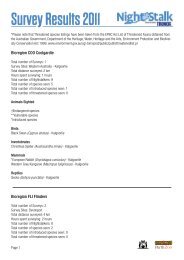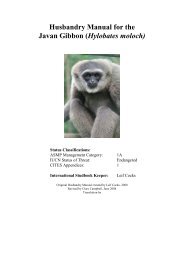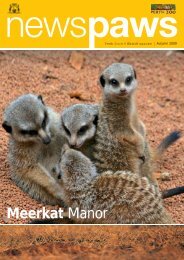Summer 2009 - Perth Zoo
Summer 2009 - Perth Zoo
Summer 2009 - Perth Zoo
Create successful ePaper yourself
Turn your PDF publications into a flip-book with our unique Google optimized e-Paper software.
Rough terrain in which the field work was completed.<br />
pinnacle rocks, a skink favourite because of the rocks’<br />
hollow, labyrinth-like nature which give the skinks plenty of<br />
places to hide.<br />
We collected the skinks into carry packs containing soil<br />
and leaf litter in which they could hide. At the end of the<br />
day we trekked back to the vehicle then drove back to<br />
base camp with the skinks.<br />
All of the skinks were weighed, measured and checked<br />
for any physical abnormalities. Faecal samples were taken,<br />
if possible, to be later checked for parasites. All skinks<br />
collected so far appear to be in excellent health.<br />
For now skinks are being kept by park staff in enclosures<br />
designed and constructed by park staff inside a modified<br />
gazebo on Christmas Island until a long-term option can<br />
be established. Here the animals are exposed to natural<br />
sunlight and the humid, local climate. We also helped<br />
construct artificial habitats for the Forest Skinks to replicate<br />
their complex habitat within pinnacle rocks.<br />
During our trip we collected 17 Blue-tailed Skinks and one<br />
Forest Skink. Since returning to <strong>Perth</strong> <strong>Zoo</strong>, Christmas<br />
Island Park staff have collected a further 21 Blue-tailed<br />
Skinks and another Forest Skink. Finding so few Forest<br />
Skinks is of concern.<br />
Meagan and Helen collect data.<br />
Highlights<br />
I work very closely with<br />
reptiles at <strong>Perth</strong> <strong>Zoo</strong> so<br />
working with skinks in the<br />
wild was very rewarding.<br />
I was very excited when<br />
I found the two new<br />
locations for the Forest<br />
Skinks were found. I<br />
approached the challenge<br />
with the mentality of ‘If I was<br />
a skink, where would I be?’<br />
Challenges<br />
Sheltered facility to house the SKinks.<br />
Simone and Helen complete health<br />
checks on Skinks.<br />
The skinks are usually found in habitats with very rough<br />
terrain – pandanus vegetation with sharp pinnacle rock<br />
cliffs with a drop into the sea on one side. Pandanus has<br />
serrated leaves, so I had to tend to leg and arm scratches<br />
more than once. Also, the humidity meant that wherever<br />
we went we had to carry plenty of water and my clothes<br />
clung to me.<br />
Benefits<br />
I value being involved with in situ conservation, and<br />
providing knowledge and experience that will improve the<br />
success of the program. Contributing to the initial stages<br />
of planning, brainstorming and implementation meant I<br />
developed problem solving skills and applied the<br />
knowledge I’ve learnt at <strong>Perth</strong> <strong>Zoo</strong> to the wild. The<br />
husbandry for the skinks was developed using a<br />
combination of our and park staff knowledge of similar<br />
species because so little is known about the ecology of<br />
Christmas Island skinks. This meant a huge learning curve<br />
but I love learning new things.<br />
Working with Helen and Simone, who are experienced<br />
professionals, and being able to learn from their vast<br />
experience was also rewarding. I enjoyed the sensory<br />
overload: being in a new place, meeting new people,<br />
adjusting to new animals and the challenges of trekking<br />
through the habitat and adjusting to the climate.<br />
All photos supplied by Helen Robertson, Simone Vitali and<br />
Meagan McPharlin.<br />
<strong>Summer</strong> <strong>2009</strong>/10 | newspaw s<br />
5






